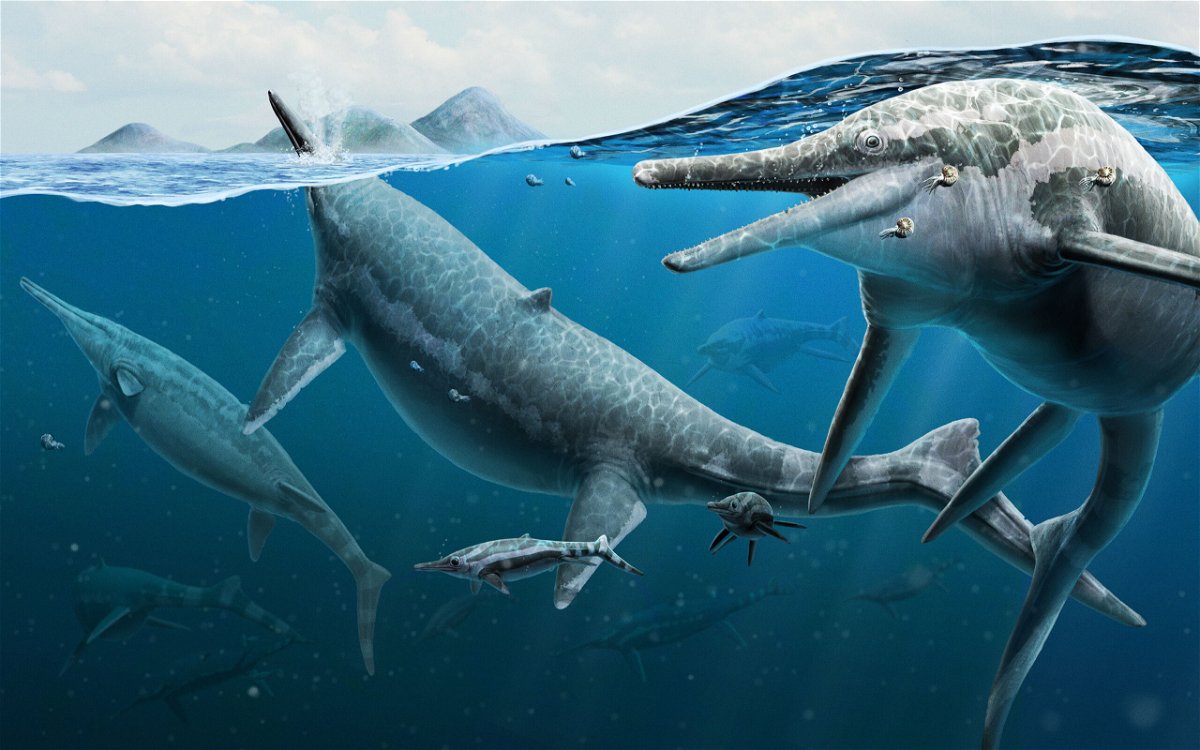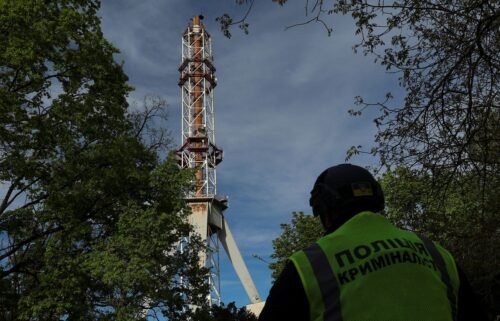Paleontologists solve mystery of fossil death bed

An artist's reconstruction depicts adult and newly born ichthyosaurs in the ocean.
By Katie Hunt, CNN
The final resting place for dozens of massive prehistoric marine reptiles lies in what’s now Nevada’s Humboldt-Toiyabe National Forest.
But why the ichthyosaurs died in such large numbers at this one particular fossil site some 230 million years ago has long been a source of debate among paleontologists. Scientifically known as Shonisaurus popularis, the species resembled a chunky dolphin and grew at least 50 feet (15.2 meters) long.
Theories suggested a mass stranding event or that the ichthyosaurs were poisoned by toxins from an algal bloom.
Now, though, scientists say that they have ruled out these hypotheses and have a much better understanding of why 37 of the ancient creatures died at the same location. The researchers believe their findings illuminate a fascinating aspect of the reptile species reproductive behavior, which is shared by some of today’s marine mammals.
“We present evidence that these ichthyosaurs died here in large numbers because they were migrating to this area to give birth for many generations across hundreds of thousands of years,” said study coauthor Nicholas Pyenson, a research geologist and curator at the Smithsonian National Museum of Natural History in Washington, DC, in a news release.
“That means this type of behavior we observe today in whales has been around for more than 200 million years.”
Present-day whale species, including blue and humpback whales, routinely migrate across oceans to breed and give birth in waters where predators are scarce. Many whales congregate year after year along the same stretches of coastline.
“There are other examples of ichthyosaur embryos and newborns, but this is the first time we have strong evidence for reproductive grouping behavior,” said study coauthor Randy Irmis, chief curator and curator of paleontology at the Natural History Museum of Utah in Salt Lake City.
“We know this is something many large marine vertebrates exhibit in the present, so it makes sense that simialr behavior occurred in the past. But we really didn’t know how far back, especially with extinct animal groups like ichthyosaurs, that have no close living relatives,” Irmis said in an email to CNN.
Detective work
The researchers from the United States, United Kingdom and Belgium used new techniques, such as 3D modeling, to investigate the fossil site, which is part of Berlin-Ichthyosaur State Park.
The team examined the chemical makeup of rocks surrounding the fossils and found no evidence of any sudden increases in organic matter, such as algae, that might have starved the creatures of oxygen.
Geological evidence also suggested the ichthyosaurs’ bones had sunk to the bottom of the sea, which then covered much of present-day Nevada, rather than along a shoreline shallow enough to suggest the marine reptiles had beached themselves.
What’s more, the team noticed the fossils were predominantly of adult ichthyosaurs, with very few other marine vertebrates present. Nor were there any juvenile ichthyosaurs.
A breakthrough came when tiny ichthyosaur remains were identified among both new fossils collected at the site and within older museum collections. Micro-CT X-ray scans revealed the small bones belonged to embryonic and newborn ichthyosaurs.
“Once it became clear that there was nothing for them to eat here, and there were large adult Shonisaurus along with embryos and newborns but no juveniles, we started to seriously consider whether this might have been a birthing ground,” said lead author Neil Kelley, a research assistant professor in Earth and environmental sciences at Vanderbilt University in Nashville, Tennessee, in the news release.
The authors concluded that the area must have been a preferred birthing habitat for the prehistoric creatures — and that the high number of fossilized remains was a result of the high numbers of ichthyosaurs that congregated there, perhaps over millions of years, to give birth.
“This is a clear ecological signal, we argue, that this was a place that Shonisaurus used to give birth, very similar to today’s whales. Now we have evidence that this sort of behavior is 230 million years old,” Pyenson said.
The journal Current Biology published the research on Monday.
The-CNN-Wire
™ & © 2022 Cable News Network, Inc., a Warner Bros. Discovery Company. All rights reserved.

